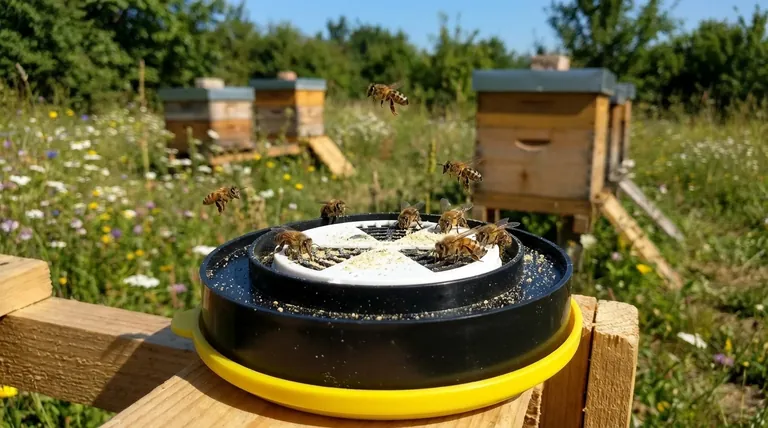At its core, a dry pollen feeder offers a significant advantage in efficiency and hive health. It provides essential nutrition with less labor for the beekeeper, reduces stress on the colony by eliminating the need to open the hive, and mimics the bees' natural foraging behavior more closely than alternative methods like pollen patties.
The decision to use a dry pollen feeder is not just about convenience; it is a strategic choice that can reduce pest pressure, minimize hive disruption, and allow the colony to store resources according to its own needs.

The Core Benefits for the Beekeeper
Choosing a feeding method often comes down to balancing the needs of the bees with the time and resources of the beekeeper. Dry feeding excels in its simplicity and efficiency.
Minimal Time and Labor
Unlike pollen patties that require mixing, forming, and careful placement, using a dry pollen feeder is straightforward. You simply fill the feeder with a pollen substitute and replenish it as the bees consume it.
This "set it and forget it" approach saves considerable time and energy, a valuable benefit for any beekeeper, especially those managing multiple hives.
Reduced Hive Disruption
Perhaps the most significant operational advantage is that dry feeders are placed outside the hive. This means you never have to open the brood box to provide supplemental protein.
Each hive opening disrupts the colony's temperature and humidity regulation, breaks propolis seals, and causes stress. By avoiding this, you promote a calmer, more stable internal environment for the bees.
How Dry Feeding Supports Colony Health
Beyond beekeeper convenience, a dry feeding strategy aligns well with the natural instincts and biological needs of a honey bee colony.
Encourages Natural Foraging and Storage
When bees collect from a dry feeder, they mix the pollen substitute with nectar and pack it into cells around the brood nest, creating "bee bread." This is their natural method of processing and storing pollen.
This allows the colony to store the protein for later use, consuming it as needed for brood rearing. Patties, in contrast, are typically consumed immediately and do not facilitate this natural storage behavior.
Mitigates Forager Aggression
During periods of pollen dearth, foragers can become aggressive and may attempt to rob weaker hives. A readily available dry pollen source can serve as a distraction.
It redirects the energy of these aggressive foragers away from robbing and toward the productive task of collecting the provided substitute.
Understanding the Trade-offs: Dry Feed vs. Pollen Patties
While dry feeding has clear advantages, it is not universally superior to pollen patties. The right choice depends on your specific goals and environmental conditions.
The Pest Management Advantage
A critical advantage of dry feeding is that it is less attractive to Small Hive Beetles (SHB). Because the pollen substitute is outside the hive, it doesn't create a breeding ground for SHB larvae within the colony.
Pollen patties, if not consumed quickly by the bees, can become a prime location for SHB to lay eggs, leading to a damaging infestation directly within the brood nest.
Weather Dependence and Consumption
Dry feeding is entirely dependent on good weather. Bees will not fly to collect pollen substitute in the rain, wind, or cold.
Pollen patties, placed directly over the brood cluster, provide guaranteed nutrition regardless of external conditions. This makes patties the better choice for emergency feeding or ensuring protein intake during a stretch of bad weather.
Choosing the Right Feeding Strategy for Your Apiary
Ultimately, the best method is the one that fits your management style, pest pressure, and specific colony needs.
- If your primary focus is convenience and minimizing hive openings: Dry feeding is the superior choice for its low-labor, non-intrusive approach.
- If your primary focus is combating Small Hive Beetles: Dry feeding significantly reduces the risk of creating a beetle breeding ground inside the hive.
- If your primary focus is delivering urgent nutrition during poor weather: Pollen patties placed directly inside the hive are the only reliable method to ensure bees get the protein they need.
By understanding these dynamics, you can select the feeding strategy that best supports both your bees and your goals as a beekeeper.
Summary Table:
| Advantage | Key Benefit |
|---|---|
| Minimal Labor | Simple 'set and forget' operation saves time, ideal for multiple hives. |
| Reduced Hive Disruption | External placement avoids opening the brood box, minimizing colony stress. |
| Natural Foraging & Storage | Encourages bees to create 'bee bread,' aligning with their natural instincts. |
| Pest Management | Less attractive to Small Hive Beetles (SHB) compared to internal pollen patties. |
| Mitigates Robbing | Provides a distraction for aggressive foragers during pollen dearth. |
Ready to enhance your apiary's efficiency and health?
As a trusted supplier for commercial apiaries and beekeeping equipment distributors, HONESTBEE provides the high-quality, durable dry pollen feeders and other essential supplies your operation needs to thrive. Our wholesale-focused approach ensures you get the reliable equipment that supports the strategic advantages outlined above.
Contact HONESTBEE today to discuss your needs and discover how our solutions can benefit your business.
Visual Guide

Related Products
- Adjustable Formic and Acetic Acid Dispenser for Bee Mite Treatment
- HONESTBEE Advanced Ergonomic Stainless Steel Hive Tool for Beekeeping
- High Quality Honey Dehumidifier Dryer Thickening Machine for Beekeeping
- Professional Dual-End Stainless Steel Hive Tool for Beekeeping
- No Grafting Queen Rearing Kit: System for Royal Jelly Production and Queen Rearing
People Also Ask
- How can beekeepers ensure their hives survive the winter? A Guide to Colony Survival
- What should be done after treating a colony for varroa mites? A Step-by-Step Guide to Verifying Success
- What is the focus of hive management during summer? Maximize Your Honey Harvest with Expert Tips
- What should beekeepers do to manage varroa mites effectively? Adopt a Proactive Monitoring Strategy
- What are some common predators and pests that target beehives? Protect Your Hives from Bears, Mites, and Beetles



















